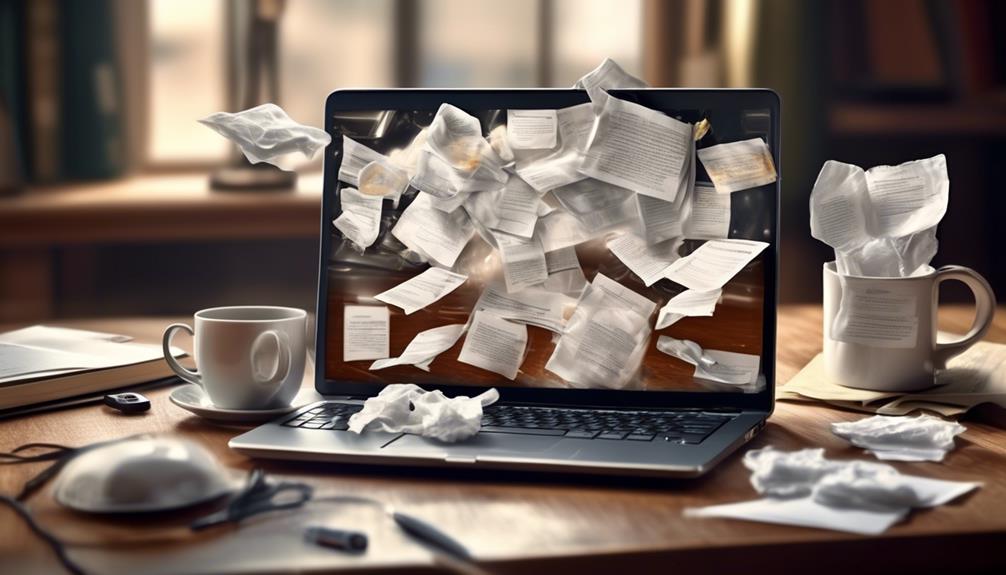When interacting with educators, our aim is to ensure that our communications are conducted with a high level of professionalism and careful attention to detail.
Knowing how to navigate the intricacies of composing an email to a teacher can significantly impact the outcome of our interactions.
Let's explore the nuances of crafting a well-structured and respectful message that conveys our thoughts effectively while fostering a positive teacher-student relationship.
Key Takeaways
- Articulate purpose respectfully and concisely
- Consider teacher's availability and workload when emailing
- Set professional and respectful tone in the email
- Express gratitude and maintain professionalism throughout the email
Reasons for Emailing a Teacher
When addressing reasons for emailing a teacher, it's essential to clearly articulate the purpose of the communication in a respectful and concise manner. Time is of the essence in a school setting, and teachers appreciate students who can efficiently convey their needs or questions.
Whether it's about a class assignment, seeking help on a topic, or clarifying a school policy, a well-written email can save both the student and the teacher valuable time. When writing to a teacher, it's crucial to use a formal tone and address them respectfully. Remember to include a clear subject line that summarizes the content of the email.
Providing specific details and avoiding unnecessary fluff will help the teacher understand your request quickly. Proofread your email for spelling and grammar errors before hitting send, as this showcases your attention to detail.
Expressing gratitude for the teacher's time and assistance at the end of the email is a courteous way to conclude your message.
Best Time to Email

Determining the most suitable time to email a teacher involves considering their availability and workload to ensure a timely response. It's essential to be respectful of the teacher's time by avoiding sending emails outside of their working hours.
When writing an email to a teacher, make sure to use a clear and specific subject line that indicates the purpose of the email. Keeping the email concise and to the point will help the teacher understand your message more efficiently. Additionally, using proper etiquette and showing gratitude in your email can go a long way in fostering a positive relationship with the teacher.
Remember to address the teacher by their last name unless they've specified otherwise and use appropriate salutations to maintain a formal tone.
To increase the likelihood of a prompt response, consider sending the email during the teacher's office hours or within school hours. Avoid emailing during holidays, weekends, or the teacher's busiest times of the day.
Starting an Email
We aim to initiate email communication with teachers by employing a professional and respectful tone from the outset.
When starting an email to a teacher, it's crucial to set the right tone to establish a positive and respectful relationship. Begin by addressing the teacher with a formal greeting, such as 'Dear Professor [Last Name],' followed by a clear and concise statement of the purpose of your email in the opening sentence.
For instance, if you're a student at XYZ High School reaching out for clarification on an assignment, make sure the subject line reflects this purpose. A subject line that tells the reader exactly what to expect will help your email stand out and get a prompt response.
Remember to use proper grammar, spelling, and punctuation throughout the email to maintain professionalism. Sign off with a polite closing, such as 'Thank you' or 'Sincerely,' followed by your Full Name to conclude the email professionally.
Writing the Email Body

Moving from the initial step of addressing a teacher with respect and professionalism, transitioning to the body of the email involves clearly articulating your purpose and needs concisely and effectively. When crafting the email body, it's crucial to follow these guidelines:
- Clearly State Your Purpose: Begin by succinctly explaining why you're reaching out to the professor. Whether it's about a question, a letter of recommendation, or any other matter, make sure your purpose is evident from the start.
- Provide Relevant Details: Offer any necessary background information to help the teacher understand your situation better. Be concise but include essential context to facilitate a comprehensive response.
- Ask Direct Questions: If you have specific inquiries, clearly articulate them in the email body. This will help the professor understand your needs and provide targeted assistance.
- Express Gratitude: As you wrap up the email body, express gratitude for the teacher's time and assistance. Ending on a polite note demonstrates professionalism and appreciation.
Can the Example Guide on Writing an Email to Your Teacher Be Used for Communicating Student Behavior Issues with Parents?
Yes, the example guide on writing an email to your teacher can be adapted for communicating student behavior issues with parents. Using effective teacher email templates parents can help in addressing concerns in a clear and professional manner, fostering open communication and cooperation in resolving the issues at hand.
Ending an Email
To effectively conclude an email, it's essential to employ a courteous closing that reflects professionalism and gratitude. When emailing teachers, it's crucial to choose an appropriate closing line such as 'Sincerely' or 'Best' followed by your full name. This closing should convey your appreciation for the teacher's time and consideration.
After crafting a well-written email body with a clear purpose, a professional and respectful tone, and correct grammar, spelling, and punctuation, the closing serves as the final impression you leave with the recipient.
Remember to include a detailed subject line that summarizes the content of your email effectively. Ending your email with a polite sign-off not only shows respect but also leaves a positive impact. Always double-check your email for any errors or typos before hitting send.
Additionally, ensure you use a professional email signature that includes your full name and contact information. By following these guidelines for ending an email to a teacher, you can create a lasting impression of professionalism and courtesy.
Frequently Asked Questions
How Do You Write an Email to a Teacher?
When writing an email to a teacher, we focus on professionalism, clarity, and respect. It's crucial to include all necessary details, such as our name, class, and the specific reason for reaching out.
We double-check for errors in spelling, grammar, and punctuation. Maintaining a formal tone and concise structure is key.
Before hitting send, we proofread for tone, correctness, and appropriateness. Our goal is to communicate effectively and respectfully with our teacher.
How Do I Write an Email to My Child's Teacher?
When emailing our child's teacher, we should maintain a professional and respectful tone. Clearly stating the purpose of the email in the opening paragraph is crucial. Keep the message concise and proofread for errors before sending. End with a polite closing and full name.
Using a formal tone and respectful address is important. Subject line should clearly state the purpose. Ensure proper grammar, spelling, and punctuation, and always proofread for clarity and professionalism.
How Do You Start an Email to a Professor Sample?
Oh, starting an email to a professor can feel like embarking on a grand adventure! We often begin by addressing them with respect, introducing ourselves, and stating our purpose clearly.
It's crucial to maintain a professional tone and avoid any casual language. Remember to conclude your email graciously.
Professors appreciate clarity and professionalism in communications, making it easier for them to assist us effectively.
How Do You Write an Email to an Old Teacher?
When writing an email to an old teacher, it's crucial to maintain a respectful and appreciative tone. Clearly state your purpose, include relevant details like your name and class, and proofread before sending.
Express gratitude at the end. Remember to address the teacher formally, use a professional subject line, and start with a polite greeting.
Provide specific examples to support your request and end with a courteous closing.
Conclusion
In conclusion, remember that teachers are there to support and guide you in your academic journey.
A study found that 83% of students felt more connected to their teachers through email communication.
By following proper email etiquette and being respectful of their time, you can effectively communicate with your teachers and build a positive relationship with them.










